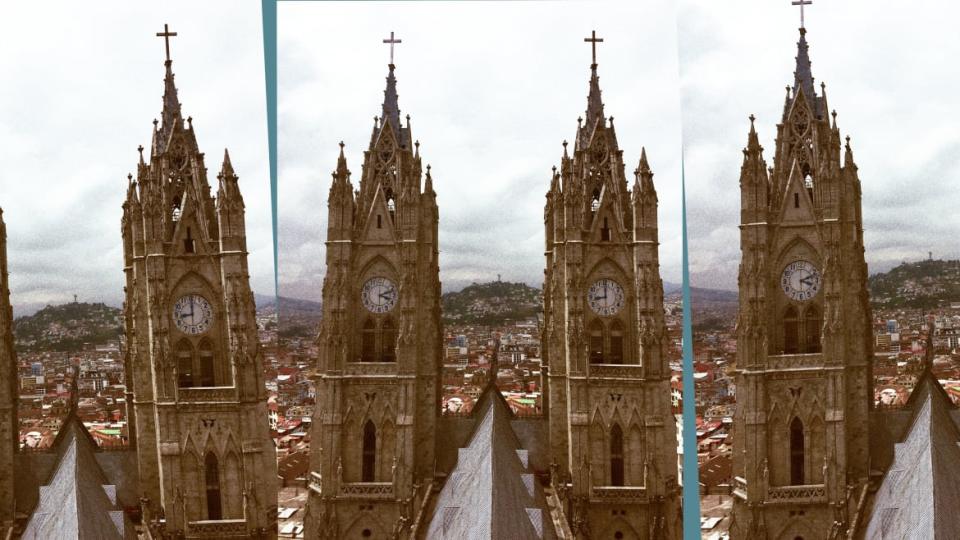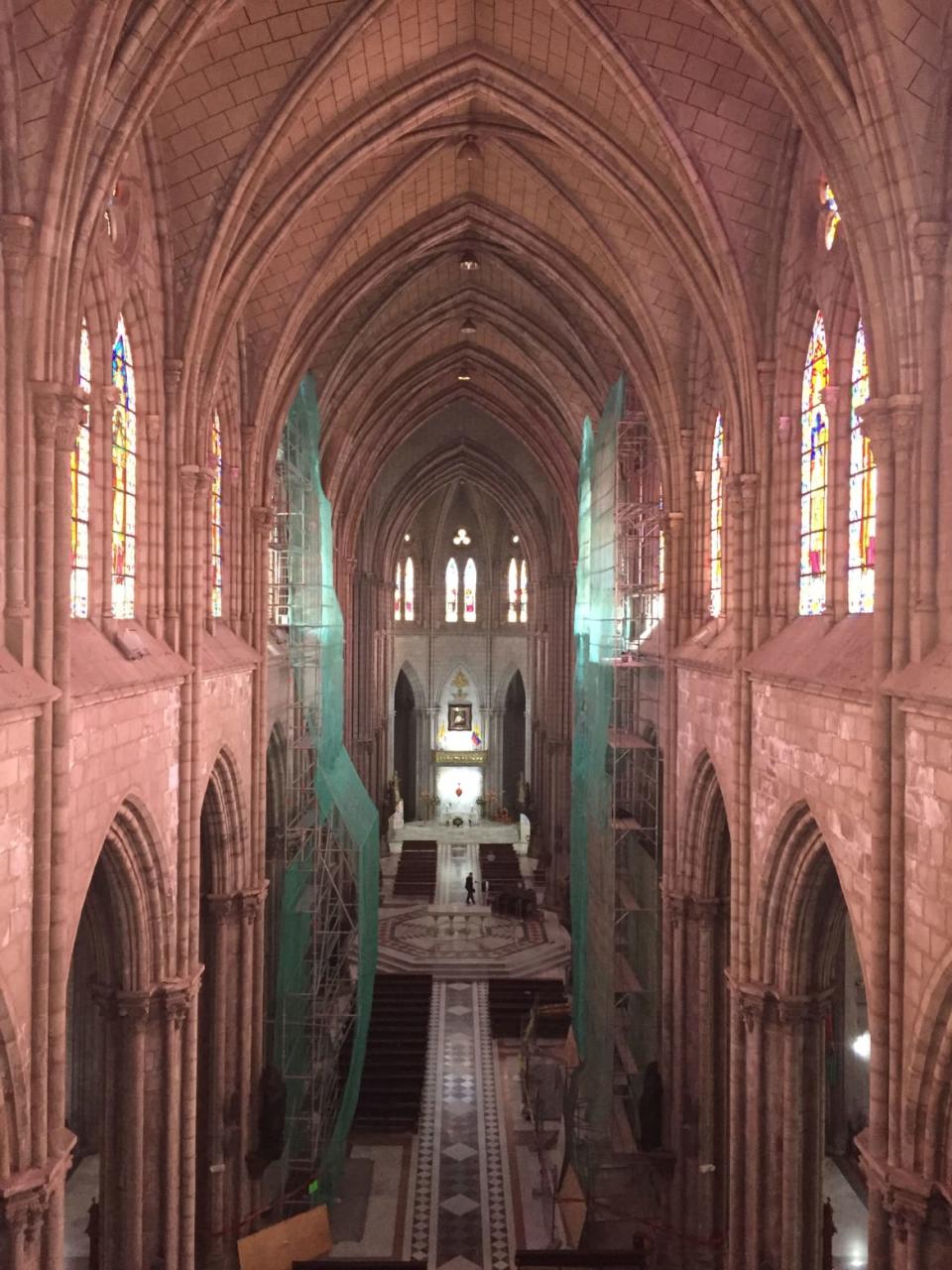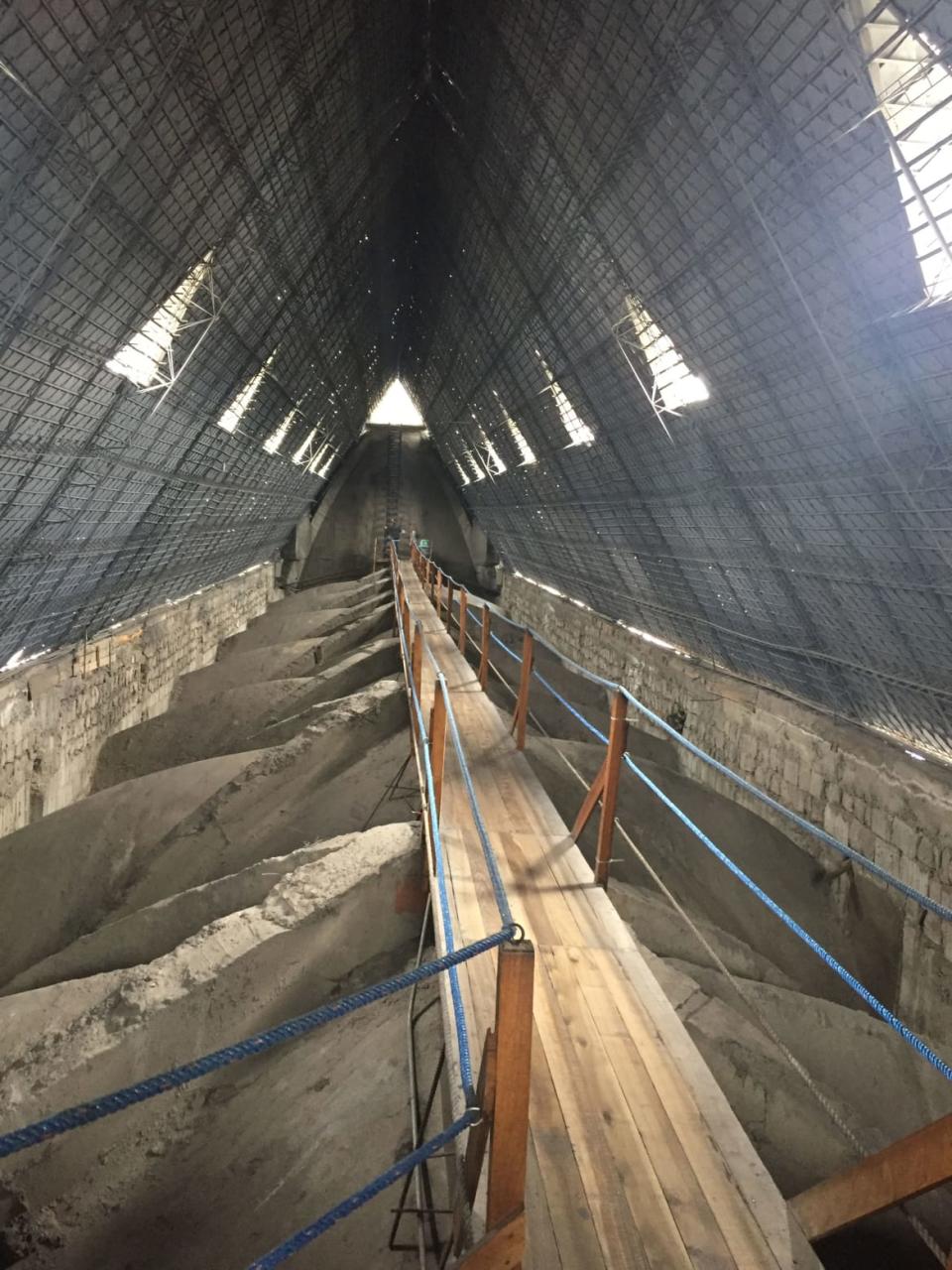Why This Massive Church in Quito Will Remain Under Construction Forever

The sight of Quito’s Basílica Del Voto Nacional is as threatening as it is beautiful.
The neo-Gothic church can be seen from nearly any point in Ecuador’s capital, which sits high in the Andean mountains. From afar its three pointed towers reach up towards the peaks of the surrounding volcanoes, piercing clouds in the sky. At ground level, the structure looms over the city, appearing in clear sight in the gaping space at the end of el centro’s Venezuela Street.
Its harsh angles, towering height, and moody air make it an intimidating sight so much so that at any given time, hurried folks will pause to stare at the strapping structure for just a moment or two. Looking at this basilica from even a kilometer away, a tourist may feel a shiver creep up towards their scalp but if a gaze from a distance causes a shred of terror, know that there’s more to be anticipated once inside its walls.

Basílica Del Voto Nacional is Spanish for Basilica of the National Vow. This is a monument iconic not only in the capital of Ecuador but for the country as a whole. Its original intentions were to honor the sacred heart of Jesus (the notion that the heart of the resurrected son of God is the symbol of his love). In a nation of devout Catholics, that holds ground but local legend has given the basilica another purpose. Even during a short visit to Quito a traveler from abroad may hear whisperings that this basilica has the power to end the world.
Want more Daily Beast travel stories? Sign up for our weekly newsletter here!
Wordly travelers may look at the Basílica Del Voto Nacional and think of Paris’s Notre Dame cathedral. They wouldn’t be far off. When in 1883 priest Julio María Matovelle dreamt up the idea of a basilica in Quito, he commissioned architect Emilio Tarlier, who took inspiration from the famous French cathedral. After the plans were drawn, construction began in the late 1880s and over the next 100 years, Ecuadorians created a masterpiece complete with kaleidoscope windows, bronze artwork, carved stone Galapagos creatures in the place of traditional gargoyles, and 24 chapels representing each of Ecuador’s provinces. In fact, the Basílica Del Voto Nacional is even the highest neo-Gothic church in all of South America. The thing is, while the great basilica opened in the summer of 1988 (three years after it was blessed by Pope John Paul ll), for superstitious reasons, the construction has yet to halt.
Most visitors to Quito will become aware of this religious Ecuadorian icon either through seeing it on a walk through the UNESCO world heritage site that is the old historic center or through exploring its interior for a two-dollar entry fee. For the full experience, those with courage could (and should) embark on the cold-sweat inducing climb to the back tower. That excursion is a must-do while in Quito.

The basilica stands at a height of 377 feet which makes for a lot of stairs to climb en route to the back tower. During that climb, winding steps bring curious wanderers past small, circular windows punched out of the walls offering a peek at stone carved sea turtles and birds from the Galapagos and then to the floor looking down on the long, narrow body of the building with rows upon rows of pews faced towards an altar outfitted with the burning candles, the sacred heart of Jesus, and the Ecuadorian flag.
Rise some more and the stairs give way to the outdoors where a balcony opens up to sweeping views of Quito. Orange tiled roofs speckle the landscape, steeples of many churches poke above neighboring homes and shops and smack dab in the middle of this scene of Quito, the statue of Mary sits perched high on a hill. (As enticing and friendly as that walk may look, locals will caution tourists to never attempt walking the footpath up towards the tower as it’s a popular spot for violent robberies.) Standing on this balcony, tourists ought to know that this view is of the most well-preserved and barely altered city center in all of Latin America. (Hence the UNESCO world heritage site label.) At 9,350 feet, Quito is the second tallest capital in the world and was once an Incan city. When the Spanish founded it in 1535, they built Quito on the ruins of what was left. This means that for centuries, the mountains that can be seen from Basílica Del Voto Nacional’s balcony have been keeping a watchful eye on those who call the bustling city home.
For three decades, the basilica has been open to devout worshippers and tourists alike. It has been well over a century since Julio María Matovelle’s workers first broke ground. Still, no matter when a curious passerby wanders inside its walls, they will see a group of Ecuadorians hard at work in some corner of the basilica. It may seem that perhaps a traveler arrived during a time when, say, one of the front towers was in need of fixing. This is not the case.
If the recent work on one of the front towers created a bit of an eyesore, unluckily for your Instagram feed, it’s because construction will in fact never be finished. Local legend has it that once this basilica is completely done, the end of the world will come. The story goes that life as we know it could be doomed thanks to this eerie-looking building that stands close to the equator in the middle of the world. As such, no detail is overlooked. There’s always work to be done, updates to be made, a spot to be fixed. This has been the case for 130 years and the people of Quito will continue to find excuses for the work to continue. Simply put: the Gothic structure is never to be finished.

That’s a hair-raising tale enough to unsettle anyone visiting Ecuador on vacation and after peering down on this Andean city from the balcony, the remaining part of the basilica tour— the rickety wooden walkway and the climb to the tower at the top— does absolutely nothing to settle the nerves. Structurally, the bridge that leads to the first ladder seems… not quite right. In fact, your travel buddy may assume that this thin wooden walkway is out-of-bounds and not intended for public use when actually, you must walk across this dimly-lit zone in order to access the ladders that leads to one of the best views of Quito. Ignore the optics: the walkway will not break. Once across, the first ladder waits. Climb to the top and you’re outdoors in daylight again.
For those who aren’t nervous with heights, the steep-angled outdoor iron ladder is the last flight up to the very top. To put it bluntly, this ladder with its spindly side bars looks better suited for an ornamental garden decoration, not a ladder taking lineups of eager visitors up to a tower. That said, enjoy the thrilling climb: it’s one of the most unique ways to experience Quito and though it may seem shaky, the risks of falling are slim.
The climb may have been, at times, unforgiving for tourists unsure of heights but the end reward is... awe-inspiring. The city below is somehow both relaxed and vibrant— as are the wonderful people of this country really. Looking closely, you might notice that the clocks display times hours apart. For those who know this South American nation’s culture well, this may get a chuckle because people from here don’t pay close attention to time: rainy weather means plans are probably cancelled, a 20-minute time estimate might as well be one hour and it’s pretty standard for plans to easily shift from 6 p.m. to 10. The fact that Quito’s two prominent clock towers in front may both display the incorrect time seems somehow appropriate. On the tips of these two towers, two crucifixes are a reminder of the significance of the Catholic faith. Beyond the basilica, Mary the mother of Jesus keeps watch from just behind. In a God-fearing nation, this might be a consolation.
At this high place in Quito, there’s much to take in. The funniest thing about this view though, is that just off to the side, the Pichincha volcano stands in the straight line of vision. It’s an active volcano and when it last erupted in 2002, even those residing in the city of Cuenca across the country awoke to thick layers of debris coating their cars. Knowing this, a foreigner may stand in that back tower puzzled by the fact that local legend has connected the end of the world with this man-made church when in its backdrop looms the menacing Pichincha volcano which, at 15,700 feet, dwarfs the basilica. From the Pichincha summit, the basilica wouldn’t even have the dignity of a toy figurine because on a clear day, you can’t even see it.
Standing up in this tower, it’s not lost on me that for every second that ticks by on these two clock faces, the volcano is brewing a hazardous mix in its crater, threatening to explode as Ecuadorians tinker away fixing their church in an effort to control their fate.
Get our top stories in your inbox every day. Sign up now!
Daily Beast Membership: Beast Inside goes deeper on the stories that matter to you. Learn more.
